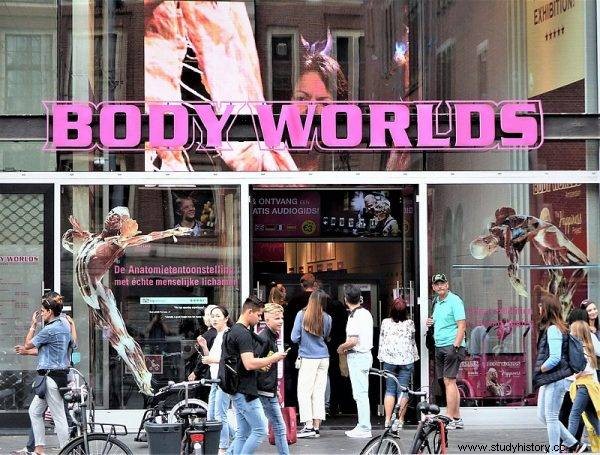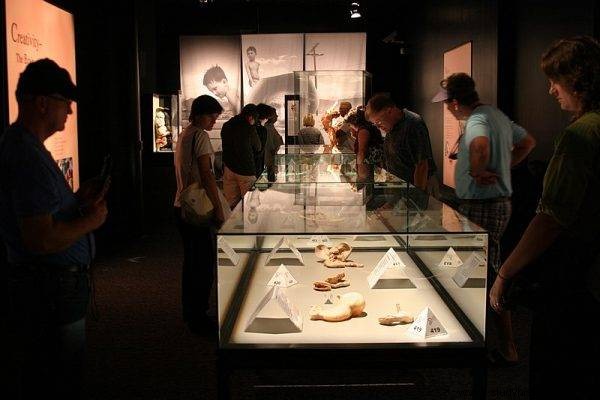In 1977, the German physician Gunther von Hagens developed a process known as plastination. Decades later, his "troupes" starred in a Bond movie.
The provocative nature of art probably does not surprise anyone anymore. What if it is a bit macabre and even pathological? How far can you go in the name of science and art? In 1977, the German physician and anatomist Gunther von Hagens developed a process later called the art of plastination. Decades later, his "troupes" starred in a Bond movie.
Gunther von Hagens
He was born in 1945 in Skalmierzyce, then under German occupation, as the son of a cook for SS troops. After the end of World War II, he left Poland with his parents and moved to the German Democratic Republic.
Before he enrolled in medical studies at the University of Jena in 1965, Gunther von Hagens worked as a nurse and transported corpses . However, he became too involved in protests against the Soviet intervention in Czechoslovakia in 1968, for which he was imprisoned. He was forced to give up his studies. Two years later, together with a group of political prisoners, he was bought out by the authorities of the Federal Republic of Germany.

Gunther von Hagens
He continued his studies in Lübeck, and then in Heidelberg, where he obtained his PhD in anesthesiology and emergency medicine . There he also started working at the Institute of Anatomy and Pathology. This field truly fascinated him.
Read also:The ideal medicine, or about the beneficial properties of the corpses of convicts
Ham cutting machine
Working as an assistant at the Institute of Anatomy and Pathology, von Hagens often wondered why why preparations of organs or tissues used in medicine are embedded in blocks of plastic or in formalin . Then he came up with - on the one hand, a brilliant and, on the other hand, highly controversial - idea to pour this plastic inside the preparation (organ) and preserve it from the inside.
According to the doctor, the organs and tissues preserved in this way would have a much greater educational value. Students could touch their surface and get to know the exact structure. As he recalls himself:
I was preparing serial samples of human kidneys for a research project. The traditional paraffin embedding of kidneys and cutting into many thin slices seemed too laborious to me, especially since I needed every fiftieth slice.
When I saw a saleswoman slicing ham in a university store , I had an idea to cut the kidneys with a sausage cutter . The "Rotary Cutting Machine", as I called it in my investment proposal, became the first plastination investment.
I used liquid plexiglass to embed the kidney slices. Air bubbles formed during the addition of the hardener had to be removed with a vacuum.
Read also:Profanacja zwłok. How was the human body illegally sourced for research?
Plastination - stopping death
In the following years, von Hagens perfected his innovative process, meticulously developing its subsequent stages. The first and most important step in plastination is to remove water and fats from the body's tissues . For this purpose, the corpse is subjected to a cool (25 degrees Celsius) bath in acetone. As an ideal solvent, acetone first replaces water in human tissues and then fats.
Then the body is placed in special vacuum tanks. They are designed to suck out all the acetone accumulated there before from the tissues.

The last stage of plastination is the coloring of tissues and organs with the appropriate dyes.
During the next stage, individual organs or the entire body are soaked in appropriate plastics - polymer resins, the composition of which is a closely guarded secret of doctor von Hagens. The preparations prepared in this way are hardened with ultraviolet rays in special gas chambers. The composition of the gas is also a secret.
The last stage of plastination is the coloring of tissues and organs with the appropriate dyes.
The entire procedure takes ... a year. There are times, however, that it has to be extended. The elephant plastination took over 3 years, and the giraffe plastination a little shorter. In a way, the complicated process allowed von Hagens to stop death. He made sure that human remains do not decompose and can stay in great shape for years.
Read also:Dragons, human corpses and perpetual motion machines - what did the Renaissance curiosities look like?
Controversial art
Nobody would see anything wrong with the invention and activities of Gunther von Hagens, if they were only for research. For decades, people have dedicated their bodies to scientific purposes, donating them to medical academies so that prospective students can learn anatomy on real organisms. In this field, von Hagens' merit is unquestionable.
The doctor went further, however. In 1995 he organized the first ever exhibition of his plastinates made from human corpses . Since then, Body Worlds shows have aroused great interest among viewers all over the world, on the other hand, and even more controversy on the other.

In 1995, he organized the first ever exhibition of his plastinates made of human corpses. Since then, Body Worlds shows have aroused great interest among viewers all over the world
The exhibition organized in 2003 in Munich ended with a court trial. According to Bavarian law, a corpse must be buried within 96 hours of death (except when it is used for scientific purposes).
Controversy is also aroused by the fact that von Hagens also plastinates animals such as dogs or cats, which become elements of… scenes at his exhibitions. There have also been allegations that the exhibitions show plastinates made from the corpses of Chinese convicts.
Scientific goals and more
Can we then consider a human corpse without skin, with a visible circulatory system visible, positioned in an artistic pose, to be art? Where does science and curiosity end and art begin?
The exhibitions are certainly a unique opportunity to get to know the human body. The exhibits show the individual systems and organs of the human body. You can see what the smoker's lungs or the brain of an Alzheimer's patient look like . This is probably one of the few opportunities to look at a human eyeball or heart. Von Hagens claims that in all his years of work he has not seen two hearts alike.
After the premiere of one of the James Bond films - Casino Royale , a lot started to be said about plastination and the "corpse sculptures" by von Hagens. from 2006. One of the scenes takes place at the Body Worlds exhibition in Miami. The screen clearly shows plastinates of people riding horses or famous characters playing poker.
Poles refused
In 2005, Gunther von Hagens wanted to buy the deserted buildings of the former state-owned farm in Sieniawa Żarska in the province. Lubuskie Voivodeship. When the townspeople found out that there was to be a plant for the production of plastinates from human corpses in their commune, as well as a huge storehouse of these artistic exhibitions, they started protests. Ultimately, the authorities of our country did not agree to such a controversial investment.

Von Hagens claims that all plastinate corpses are legally sourced via donation.
Shortly thereafter, it was also refused to organize two Body Worlds exhibitions in Poznań and Warsaw. The decision was explained by religious and ideological issues and respect for the corpse . Interestingly, in Great Britain, Hagens' plastinates met with such recognition that the local health service and the Red Cross are looking for ... donors.
Doctor Death
Back in the 1980s, Gunther von Hagens founded a plastinate manufacturing company for scientific purposes. Today, his facilities are located in Guben, Germany, but also in China and Kyrgyzstan, where since 1999 the doctor has been the head of the Plastination Institute of the National Medical University.
Von Hagens claims that all plastinate cadavers are legally sourced via donation . There has also been a special website for some time where potential donors can register . Some time ago, the doctor revealed that he had Parkinson's disease and would like his body to become an exhibit when he died.

01/02/2018 Krakow An exhibition "Body Worlds" has opened in the Bonarka Shopping Center. The exhibition presents authentic human bodies subjected to the plastination method of Dr. Gunther von Hagens, photo:Beata Zawrzel / REPORTER
When entering the exhibition, we can read his short message:
By showing what is physical and tangible, the Body Worlds exhibition reminds visitors of the elusive and unfathomable. The plastinated body after death emphasizes the importance of the soul by highlighting its absence.
Plastination turns a body that is subject to individual mourning into an object we respect , enabling us to learn, broaden our horizons and increase our awareness.
I hope that Body Worlds will be a place of enlightenment and reflection, and even self-discovery of a philosophical and religious nature, a place open to interpretation, regardless of the recipient's origin and life philosophy.
